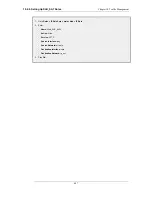
10.4.6. Setting Up SLB_SAT Rules
The key component in setting up SLB are IP rules that have SLB_SAT as the action. The steps that
should be followed for setting up such rules are:
1.
Define an IP address object for each server for which SLB is to enabled.
2.
Define an IP address group object which includes all these individual objects.
3.
Define an SLB_SAT rule in the IP rule set which refers to this IP address group and where all
other SLB parameters are defined.
4.
Define a further rule that duplicates the source/destination interface/network of the SLB_SAT
rule that permits the traffic through. This could be one rule or a combination of rules using the
actions:
•
Allow
•
NAT
Note: FwdFast rules should not be used with SLB
In order to function, SLB requires that the NetDefendOS state engine keeps track of
connections. FwdFast IP rules should not be used with SLB since packets that are
forwarded by these rules are under state engine control.
The table below shows the rules that would be defined for a typical scenario of a set of webservers
behind the NetDefend Firewall for which the load is being balanced. The Allow rule allows external
clients to access the webservers.
Rule Name
Rule Type
Src Interface
Src Network
Dest Interface
Dest Network
WEB_SLB
SLB_SAT
any
all-nets
core
ip_ext
WEB_SLB_ALW
Allow
any
all-nets
core
ip_ext
If there are clients on the same network as the webservers that also need access to those webservers
then an NAT rule would also be used:
Rule Name
Rule Type
Src Interface
Src Network
Dest Interface
Dest Network
WEB_SLB
SLB_SAT
any
all-nets
core
ip_ext
WEB_SLB_NAT
NAT
lan
lannet
core
ip_ext
WEB_SLB_ALW
Allow
any
all-nets
core
ip_ext
Note that the destination interface is specified as core, meaning NetDefendOS itself deals with this.
The key advantage of having a separate Allow rule is that the webservers can log the exact IP
address that is generating external requests. Using only a NAT rule, which is possible, means that
webservers would see only the IP address of the NetDefend Firewall.
Example 10.3. Setting up SLB
In this example server load balancing is to be done between 2 HTTP webservers which are situated behind the
NetDefend Firewall. The 2 webservers have the private IP addresses 192.168.1.10 and 192.168.1.11
respectively. The default SLB values for monitoring, distribution method and stickiness are used.
A NAT rule is used in conjunction with the SLB_SAT rule so that clients behind the firewall can access the
webservers. An Allow rule is used to allow access by external clients.
10.4.6. Setting Up SLB_SAT Rules
Chapter 10. Traffic Management
485
Summary of Contents for DFL-1600 - Security Appliance
Page 27: ...1 3 NetDefendOS State Engine Packet Flow Chapter 1 NetDefendOS Overview 27 ...
Page 79: ...2 7 3 Restore to Factory Defaults Chapter 2 Management and Maintenance 79 ...
Page 146: ...3 9 DNS Chapter 3 Fundamentals 146 ...
Page 227: ...4 7 5 Advanced Settings for Transparent Mode Chapter 4 Routing 227 ...
Page 241: ...5 4 IP Pools Chapter 5 DHCP Services 241 ...
Page 339: ...6 7 Blacklisting Hosts and Networks Chapter 6 Security Mechanisms 339 ...
Page 360: ...7 4 7 SAT and FwdFast Rules Chapter 7 Address Translation 360 ...
Page 382: ...8 3 Customizing HTML Pages Chapter 8 User Authentication 382 ...
Page 386: ... The TLS ALG 9 1 5 The TLS Alternative for VPN Chapter 9 VPN 386 ...
Page 439: ...Figure 9 3 PPTP Client Usage 9 5 4 PPTP L2TP Clients Chapter 9 VPN 439 ...
Page 450: ...9 7 6 Specific Symptoms Chapter 9 VPN 450 ...
Page 488: ...10 4 6 Setting Up SLB_SAT Rules Chapter 10 Traffic Management 488 ...
Page 503: ...11 6 HA Advanced Settings Chapter 11 High Availability 503 ...
Page 510: ...12 3 5 Limitations Chapter 12 ZoneDefense 510 ...
Page 533: ...13 9 Miscellaneous Settings Chapter 13 Advanced Settings 533 ...








































